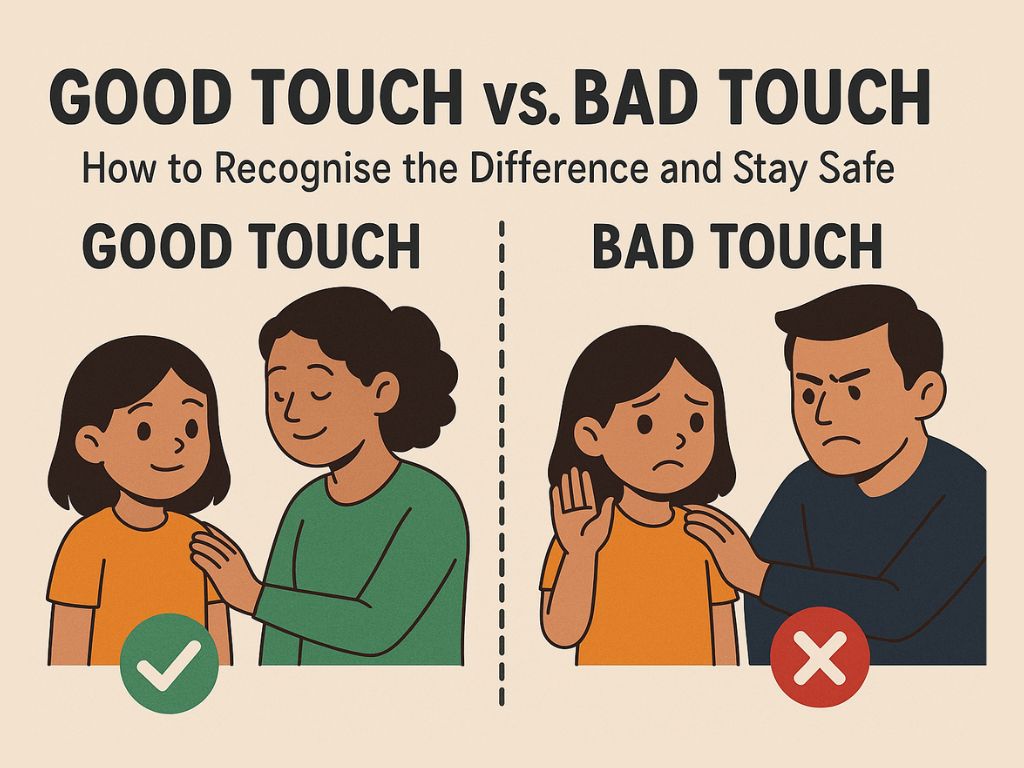Touch is an essential part of human connection. A hug from a loved one, a handshake after a successful deal, or a comforting pat on the back can make us feel valued and safe. However, not all touches are positive. Some touches can make people feel uncomfortable, scared, or even unsafe. Understanding the difference between good touch and bad touch is crucial for people of all ages, from children to adults.
This guide will help you identify the difference, recognize warning signs, and take necessary actions to ensure safety for yourself and those around you.
Good Touch vs. Bad Touch
|
Aspect |
Good Touch |
Bad Touch |
|
Definition |
A touch that makes a person feel safe, loved, and comfortable. |
A touch that makes a person feel uncomfortable, scared, or violated. |
|
Examples |
Hugging a parent, shaking hands, high-fiving a friend, a doctor examining with permission. |
Touching private parts without consent, forced hugs/kisses, hitting, inappropriate touching. |
|
Emotional Impact |
Brings comfort, security, and warmth. |
Causes fear, anxiety, confusion, or distress. |
|
Consent |
Usually welcomed and accepted. |
Often forced, unwanted, or secretive. |
|
Purpose |
Expresses care, love, appreciation, or encouragement. |
Can be used to dominate, manipulate, harm, or exploit. |
|
Response Needed |
No action needed; it’s positive and safe. |
Can be used to dominate, manipulate, harm, or exploit. |
|
Legal Implications |
Completely acceptable in society. |
Can be illegal (harassment, abuse, assault). |
How to Stay Safe from Bad Touch
For Children
Children are the most vulnerable when it comes to bad touch. They must be taught early on how to recognize and react to inappropriate situations.
- The ‘No-Go-Tell’ Rule: Teach children to say NO, GO away, and TELL a trusted adult if they experience bad touch.
- Trust Their Feelings: Let children know that if a touch makes them feel bad, they should trust their instincts and report it.
- Teach About Private Parts: Help children understand that private parts are those covered by underwear and should not be touched by others unless for medical reasons (with parental presence).
- Encourage Open Conversations: Children should feel comfortable discussing their concerns with parents, teachers, or guardians.
- Role-Playing Scenarios: Practice different situations where they may need to say no or ask for help.
For Teenagers
Teenagers often face peer pressure and social challenges that can blur the lines between good and bad touch.
- Understanding Consent: They should be taught that consent must always be given and respected.
- Saying No Assertively: Teens should feel empowered to say no to unwanted advances.
- Recognizing Peer Pressure: Teaching them to differentiate between friendly gestures and inappropriate behavior is essential.
- Online Safety: Educate teens about inappropriate online interactions, such as unwanted messages or requests.
- Reporting Inappropriate Behavior: Encourage them to speak up if they experience harassment or uncomfortable situations.
For Adults
Adults may experience bad touch in various settings, including workplaces, social gatherings, or even within personal relationships.
- Understanding Workplace Harassment: Inappropriate touching in professional settings is unacceptable and should be reported.
- Setting Personal Boundaries: Communicate clearly when a touch is unwelcome.
- Speaking Up Against Harassment: Whether in social settings or workplaces, speaking up can prevent further misconduct.
- Recognizing Coercion in Relationships: No one should feel forced to accept physical contact in a relationship.
- Legal Protections: Familiarize yourself with laws that protect against sexual harassment and abuse.
Warning Signs That Someone Might Have Experienced Bad Touch
Sometimes, victims may not openly talk about their experiences, making it crucial to recognize warning signs.
- Sudden withdrawal or behavioral changes.
- Fear or anxiety around certain people or places.
- Unusual avoidance of physical contact.
- Regression in behavior (e.g., bedwetting in children).
- Loss of confidence or difficulty concentrating.
- Expressing fear of being left alone with specific individuals.
- Drawing or role-playing inappropriate situations.
If you notice these signs, create a safe space for them to talk, listen without judgment, and offer support.
What to Do If You or Someone You Know Has Experienced Bad Touch
- Stay Calm and Listen: Reacting with anger or panic might discourage the person from opening up further.
- Believe Them: Dismissing their experience can lead to emotional trauma. Always validate their feelings.
- Reassure Them: Let them know they are not at fault and that you are there to help.
- Report the Incident: If the situation involves abuse, report it to the appropriate authorities (such as child protection services, HR departments, or law enforcement).
- Seek Professional Help: Therapy or counseling can help victims process their experience and heal.
- Create a Support System: Encourage victims to talk to trusted friends, family, or professionals.
Conclusion
Recognizing the difference between good touch and bad touch is crucial in building a safer society. By educating ourselves and those around us, we can empower individuals to set boundaries, say no when necessary, and seek help if needed.
Conversations about touch should not be a one-time discussion but an ongoing effort to ensure everyone; children, teenagers, and adults feels safe and respected in their interactions.
If you or someone you know is experiencing inappropriate touch, do not hesitate to speak up. Moreover, getting in touch with Dr Kishore’s Ratnam Schools can reduce your stress of teaching your kids these important aspects, as they make sure every child understands and recognises good touch vs. bad touch. Awareness and action are the keys to preventing and addressing bad touch. Let’s work together to create a world where everyone feels secure, valued, and free from harm.


